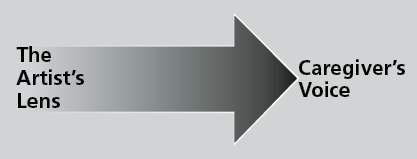The Creative Caregiving Initiative
Arts at the Intersection of Wellness
A Personal Experience Informs Philanthropy
When my mom was ill and dying of bone cancer, we told stories. Mom was a master storyteller, so I came by this talent naturally along with the other nurturing she provided. For as long as I remember, we had great fun making up stories about people on the street and at restaurants, and even whispering story lines in church! As an adult, the roles reversed as I gave care and encouraged Mom to recall old stories and make up new ones. Storytelling lit up her voice and vanquished some of the pain consuming her body. When Mark, my husband, was dying of leukemia, we listened to all our favorite music, dancing and singing to favorite melodies and artists, and then as the disease progressed, we only sang. Because the arts have always been central in my life, I integrated storytelling and music with caregiving. During my role as caregiver, I dealt with each day more intuitively rather than consciously, using the arts as a respite during this time. Looking back, I see that the arts helped me by substituting purpose for anger, hope for despair, dignity and self-worth for depression.
Caregiving transformed my view of life and created a passion for the possibilities of philanthropy and art to make a difference as we age, stay well, and experience illness. The founding mission of The Pabst Charitable Foundation for the Arts was to “nurture artists and art forms for innovative, diverse, and interdisciplinary collaboration impacting communities.” Today, that mission focuses on the potential of the arts to impact wellness. From 2007 on, The Pabst Foundation has assisted local partners in Central Florida in providing support for caregivers and artists: the University of Central Florida, the Atlantic Center for the Arts, Share the Care, Easter Seals Florida, Inc., the Brain Fitness Club, and the Alzheimer’s and Dementia Resource Center.
Then one fortuitous day in 2012, I met Gay Hanna, executive director of the National Center for Creative Aging (NCCA). Together, we realized that the goal for supporting family caregivers and improving their overall quality of life could be realized locally, across the country, and around the world. Hanna explains:
With my caregiver’s and funder’s hats on, I realized we were forging both a local and a national set of partners whose expertise, wisdom, and passion were aligned with creating a collaboration that would deliver a user-friendly online platform of creative exercises for the family and professional caregiver to use at home. The Creative Caregiving Initiative, as it came to be known, would include a caregiver “toolkit” having the potential to provide training, artistic content, and feedback by and for caregivers. This article describes the three-year evolution and journey from vision to implementation along with challenges, successes, and lessons learned.
Why Develop a Creative Caregiving Initiative and “Caregiver Toolkit”?
Synergies between arts, health, wellness, and medicine have been around a long time. Early Greek and Roman literature stressed the benefits of the arts on health and well-being. Today, our aging populations demand that we find alternative ways to support aging, wellness, and related health conditions. Of particular urgency is the growing number of persons with memory loss. One out of every eight persons in the United States will develop Alzheimer’s or age-related dementia. The professional artists (Glazner, Freidman, Basting, Genné, and Lokon) were developing evidence-based documentation of their work on aging and memory-related diseases, so we were optimistic that their work and best practices could be translated to developing a Creative Caregiving Initiative, with one of the products being a “caregiver toolkit.”
We decided to focus on the needs of caregivers caring for those with Alzheimer’s and related diseases. We asked these questions: Could the positive impact of art interventions experienced by a person with Alzheimer’s or dementia be extended to provide respite to the caregiver? Could we create artistic exercises for use by caregivers in the home with loved ones? Would using art as an integral part of daily life impact stress, loneliness, and overall sense of well-being?
More than forty-two million caregivers in the United States provide free care for at least twenty hours per week to a loved one or friend. Caregiver support and service add up to approximately $450 billion each year, but that dollar savings to society comes at a cost to caregivers’ sense of well-being and quality of life. Nearly 40 percent of caregivers experience some medical issue either during or after having been a caregiver.1
What does a typical caregiver’s day look like?
This bittersweet photograph captures that typical day, often filled with isolation, loneliness, stress, and depression with patches of sunlight and hope. In that patch of light, we saw the arts as a rising beacon for families dealing with illness; we also believed that the arts (a toolkit of creative resources) could contribute to more quality days as we age. Creativity could fill the isolation felt by both caregivers and families if that creativity was integrated into daily life like mealtime, bedtime, and so on. Often, the source of caregivers’ stress is the frustration that they are not providing enough stimulation and inspiration for their loved ones. We reasoned that the toolkit would provide ideas for creating quality days.
James L. Brooks, a director of The Pabst Foundation comments:
Building the Foundation for the Creative Caregiving Initiative
The story of this initiative is all about the right partners at the right time. In 2013, NCCA and the University of Central Florida (UCF) held a think tank to discuss the initiative and to select participants from across colleges at the university, with the College of Arts and Humanities leading the effort. Atlantic Center for the Arts (ACA), an artist-in-residence program supporting interdisciplinary arts collaboration and practice in New Smyrna Beach, Florida, stepped forward as a place where the artists could meet in retreat to reflect and create. The support of both UCF and ACA was critical in providing the intellectual base for the initiative and the place and time for reflection that the initiative and “toolkit” required.
The Pabst Charitable Foundation for the Arts supported the initial artist retreats in Florida; we were joined early on by Bader Philanthropies and The Rosalinde and Arthur Gilbert Foundation. Helen Ramon, program officer of Bader Philanthropies, says:
Martin H. Blank Jr., chief operating officer and codirector of The Rosalinde and Arthur Gilbert Foundation, says:
Our Biggest Challenge: Translating Artist’s Best Practices to Caregivers
In May 2013, the professional artists came to ACA. Each artist brought their current process and program to the team. Their task was to translate their evidence-based creative techniques (the artist’s lens) to a user-friendly set of creative exercises for caregivers (the caregiver’s voice).
Gary Glazner, founder of the Alzheimer’s Poetry Project, says about the process:
Our next key partners, caregiving agencies and day care centers in Central Florida, joined us at ACA: Share the Care, Easter Seals, the Alzheimer’s and Dementia Resource Center, and the Brain Fitness Club. These caregiver organizations were critical for helping us understand the “caregiver’s voice” and provided important early information on what makes for a quality day for caregivers. The professional artists then began the process of translating their work to a user-friendly format for caregivers. Retreats and focus groups were held in Orlando, Milwaukee, and Los Angeles over a two-year period.
Greg Finch, NCCA field services director, describeshis experience:
By fall 2014, we were on the way to answering key questions with the right mix of wise and dedicated partners: Who has and is using best practices for arts interventions with Alzheimer’s and dementia? (artists) How can we translate these best practices from the artist’s lens to the caregiver’s voice? (caregiving agencies) Where can we find space and time to translate best practices to user-friendly exercises for caregivers? Where is the space and time for reflection leading to this potential breakthrough? (Atlantic Center for the Arts)
However, a critical question remained as we began 2015: How could we develop an evidence base for our work? Our partner from the beginning, the University of Central Florida, was key, from convening the initial think tank (administrators, faculty, and students) held on campus to the all-important research component required three years later. Beta testing for the Creative Caregiving Initiative “toolkit” commenced in April 2015 with the team of Thomas Wan (UCF), Mary Ellen Grant (CEO of Share the Care in Orlando), and Greg Finch (NCCA). The research documented caregiver burden, depression, and overall quality of life. As you read this, researchers will be concluding beta testing but will continue to develop more evidence to support the initiative.
The Creative Caregiving Initiative Launch
The Creative Caregiving Initiative was introduced in May 2015 at the NCCA Annual Leadership Conference in Washington, D.C. Finch describes the final, evolving product:
Key Learnings from a Funder’s Perspective
- The initiative required both national and local partners, each having a specific role at each stage.
- The product needed to be a “living toolkit,” changing and adapting to caregivers’ needs.
- All partners needed to feel ownership with specific roles at both the national and local levels; geographic and cultural diversity was paramount.
- Balance between national interest and local community interest is critical to ongoing improvements, research, and sustainability.
- Multiple funders collaborating on the project accelerates progress and broadens reach.
What’s Next?
Gay Hanna, of NCCA, says:
Final Thoughts
My quality days as a caregiver would have been more numerous and my caregiving would have been more inspired if the Creative Caregiving Initiative and toolkit had been available. On behalf of all the partners who made this initiative possible, our hope is that more caregivers will find their path less lonesome and their days less stressful, and that they will look back on their caregiving time with a sense of great memory and family legacy to be shared, with the arts as an integral part of their daily lives.
On Tuesday, October 13, 2015, the Third Annual Arts and Wellness Symposium will be held in Orlando, Florida, at the Dr. Phillips Center for the Performing Arts. Jose Fernandez, dean of the College of Arts and Humanities, and Hanna, executive director of the NCCA, will host the event. The Creative Caregiving Initiative and toolkit will be showcased. For information, go to www.pabstfoundation.org and www.creativeaging.org.
NOTES
- These statistics are from Lynn Feinberg, Susan C. Reinhard, Ari Houser, and Rita Choula, Valuing the Invaluable: 2011 Update, The Growing Contributions and Costs of Family Caregiving (Washington, D.C.: AARP Public Policy Institute, 2011).
- Ibid.


